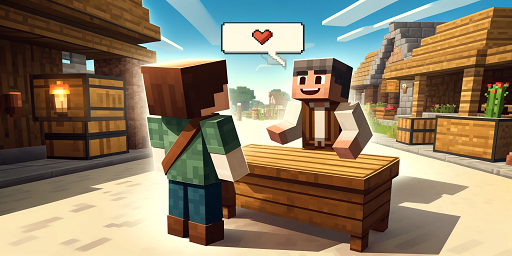Minecraft Villagers are an essential part of the game, especially in the later stages, where they become incredibly important and helpful. They not only add a lively atmosphere to the villages but also play a crucial role in the game’s economy and trading system. This comprehensive guide will cover everything you need to know about Villagers, from their professions to the trading system, and offer tips on how to protect them effectively.
What are Minecraft Villagers?
Minecraft Villagers are passive NPCs (non-playable characters) that live in villages and perform various professions. They interact with players and can be traded with to obtain useful items. Villagers have different professions determined by specific blocks. This guide provides a comprehensive overview of everything you need to know about Villagers.
The Different Types of Villagers
The 13 Villager Professions
There are a total of 13 different professions that Villagers can have in Minecraft. These professions are determined by specific job site blocks. Here they are in detail:
Farmer (Composter)
- Advantages: Provides food and seeds.
- Use: Ideal for food production and agricultural needs.
- Synergies: Combines well with other professions for sustainable village economy.
Librarian (Bookshelf)
- Advantages: Offers enchanted books and compasses.
- Use: Perfect for players needing access to powerful enchantments.
- Synergies: Works well with blacksmiths to create powerful weapons and tools.
Cleric (Brewing Stand)
- Advantages: Trades ender pearls and enchanted items.
- Use: Important for players wanting to reach the End or brew potions.
- Synergies: Combines well with librarians for comprehensive enchanting and potion options.
Armorer (Blast Furnace)
- Advantages: Provides armor of all kinds.
- Use: Essential for building a strong defense.
- Synergies: Complements weapon and toolsmiths.
Toolsmith (Grindstone)
- Advantages: Trades tools like pickaxes and axes.
- Use: Ideal for obtaining high-quality tools needed in the game.
- Synergies: Synergizes with armorers and weaponsmiths for complete gear.
Weaponsmith (Smithing Table)
- Advantages: Provides weapons like swords and bows.
- Use: Essential for combat against mobs and other players.
- Synergies: Combines well with librarians and armorers.
Leatherworker (Cauldron)
- Advantages: Trades leather goods and saddles.
- Use: Useful for players who ride often or need leather.
- Synergies: Combines with farmers for sustainable leather production.
Fisherman (Barrel)
- Advantages: Provides fish and fishing rods.
- Use: Practical for a reliable food source and materials for fishing rods.
- Synergies: Ideal in coastal or river villages where fishing is accessible.
Shepherd (Loom)
- Advantages: Trades wool and banners.
- Use: Good for decorative purposes and trading wool.
- Synergies: Works well with farmers for sheep breeding.
Cartographer (Cartography Table)
- Advantages: Offers maps and banner patterns.
- Use: Ideal for exploration and navigation in the Minecraft world.
- Synergies: Complements librarians for comprehensive cartographic and enchanting abilities.
Mason (Stonecutter)
- Advantages: Trades stones and stone products.
- Use: Perfect for building and decorating structures.
- Synergies: Combines well with all professions to build robust structures.
Fletcher (Fletching Table)
- Advantages: Provides arrows and bows.
- Use: Important for ranged combat and hunting.
- Synergies: Combines well with weaponsmiths for comprehensive combat gear.
Butcher (Smoker)
- Advantages: Trades meat and offers cooked meat.
- Use: Essential for a reliable food supply.
- Synergies: Works well with farmers and fishermen for a varied diet.
How to Place Specific Job Site Blocks for Villagers and Where to Find Them
In Minecraft, Villagers take on professions based on the job site blocks placed near them. These blocks are specific items that assign professions, such as a composter for a Farmer or a bookshelf for a Librarian. To place these blocks, you must first craft or find them in the game world. For example, a composter can be made from wooden planks, while a bookshelf is crafted from wood and books. Once you have the appropriate job site block, place it near an unemployed Villager, who will then take on that profession. Make sure the Villager does not have other job site blocks nearby to ensure they take the desired profession.
Unemployed Villagers and Nitwits
Unemployed Villagers are those who do not yet have a profession. They can take on a profession by placing an appropriate job site block near them. Nitwits, however, cannot take on any profession and are therefore useless for trading.
How Can I Change the Profession of Villagers Who Already Have a Job?
If a Villager already has a profession, but you want them to take on a different one, you need to remove the job site block that defines their current profession. Once the block is removed, the Villager will lose their profession and appear as an unemployed Villager again. You can then place a new job site block nearby to assign them a new profession. It is important to ensure that the Villager has access to the new job site block and that there are no other competing job site blocks nearby that could distract them.
Finding Villagers and Exploring Villages
What are Biomes?
Biomes in Minecraft are different regions in the game world characterized by specific climates, vegetation, and terrain. Examples of biomes include plains, deserts, and savannas. Each biome has its unique features, such as flat grasslands and frequent animals in the plains, sand and cacti in the desert, or acacia trees in the savanna. Recognizing and exploring these biomes is crucial to finding Villager villages and optimizing the game’s resources.
Villagers can be found in villages that spawn in various biomes. Here are some tips for efficiently finding and transporting Villagers:
- Search for villages in plains, desert, and savanna biomes.
- Use boats or minecarts to transport Villagers.
- Build safe pathways and shelters to ease the transport.
How to Transport Villagers with Boats or Minecarts
Villagers can be transported in Minecraft using boats or minecarts. To transport a Villager with a boat, place the boat next to the Villager and wait for them to get in. You can then maneuver the boat on water or over flat land surfaces. For minecart transport, lay tracks from the Villager’s current location to your desired destination. Place a minecart on the tracks and push it near the Villager so that they automatically get in when the minecart touches them. Ensure that the tracks are continuously connected and have no interruptions for a smooth journey. At the destination, simply destroy the boat or minecart to let the Villager out.
The Villager Trading System
Trading with Villagers is a great way to obtain valuable items and resources. Here are some basic trading strategies:
- Trade with Farmers for simple and useful items like food.
- Use Librarians to get enchanted books.
- Armorers and Weaponsmiths often offer high-quality gear.
Villager Breeding and Population Increase
Villagers can be bred to increase the population of your village. Here are the requirements for successful breeding:
- Ensure there are enough beds for the Villagers.
- Feed the Villagers with food (bread, carrots, potatoes, or beets).
- Build a Villager farm to make breeding efficient.
Protecting and Defending Villagers
Villagers are vulnerable to attacks from zombies and other hostile mobs. Here are some protective measures:
Threats to Villagers
- Zombies can attack Villagers and turn them into Zombie Villagers.
- Raids can pose a significant threat to Villagers and villages.
Protective Measures and Buildings
- Build secure houses with lighting and fences.
- Erect defensive structures like iron golems and walls.
- Use doors and trapdoors to protect Villagers from attacks.
What are Iron Golems and How to Create Them?
Iron Golems are large, powerful creatures that protect Villagers and players in Minecraft. They defend villages against hostile mobs like zombies and raids. To create an Iron Golem, you need four iron blocks and a carved pumpkin. Place the iron blocks in a T-shape (three blocks horizontally and one block vertically underneath). Then, place the carved pumpkin on top of the middle of the T. The Iron Golem will immediately spawn and protect the village. It is important to strategically place Iron Golems in your village for effective defense.
Moving Villagers
If you want to move your Villagers, the new village must be at least 40 blocks away from the boundary of the old village. Otherwise, the Villagers will simply return to the old village. The new village must have at least one bed, and then you can kidnap residents from another village and settle them in the new village. To do this, lay tracks from the existing village to your new village. Ensure the tracks are continuously connected and built so that the carts can travel smoothly without crashing or derailing. Ensure there is a mechanism at the end of the tracks to stop the cart (e.g., a block).
Send a cart down the tracks until it hits a Villager. When the cart touches a Villager, they will automatically get in. Send the cart towards the new village. To let the Villager out, simply destroy the cart once it arrives in the new village.
Conclusion: How Villagers Can Enrich Your Server!
Villagers can significantly enhance your Minecraft server. They bring villages to life, enable trading, and contribute to the game’s economy. Learn more about how you can use Villagers on your server: Rent a Minecraft Server.
Frequently Asked Questions and Answers about Minecraft Villagers:
How do I get new Villagers in my village?
By breeding existing Villagers or moving Villagers from other villages.What professions can Villagers have and how do I choose them?
There are 13 different professions, such as Farmer, Blacksmith, or Librarian. The profession is determined by placing specific blocks like a composter or an anvil.What to do if my Villagers are not taking new professions?
Make sure the Villager does not have an existing profession and that there are enough job site blocks.How do I protect my Villagers from zombies?
Build secure houses, use fences and lighting, and erect defensive structures.
More interesting articles
How to Build a Villager Trading Post: Acquire Valuable Items Through Trading
Build an Automatic Potion Brewer in Minecraft: Guide & Tips
How to Build a Minecraft Monster Trap: Automatically Gather Endless Resources




